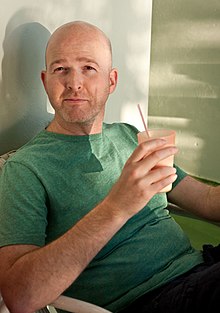Stefan Langerman false Swarzberg is a Belgian computer scientist and mathematician whose research topics include computational geometry, data structures, and recreational mathematics. He is professor and co-head of the algorithms research group at the Université libre de Bruxelles (ULB) with Jean Cardinal. He is a director of research for the Belgian Fonds de la Recherche Scientifique (FRS–FNRS)[1][2].
Stefan Langerman | |
|---|---|
 Bellairs, 2015 | |
| Nationality | Belgian |
| Education | |
| Scientific career | |
| Institutions | |
| Doctoral advisor | William Steiger |
Education and career edit
Langerman left his Belgian secondary school at age 13 and was admitted by examination to the École polytechnique of the Université libre de Bruxelles. He studied civil engineering there for two years before switching his course of study to computer science, and earning a licenciate.[3]
After working as a user interface programmer for the Center for Digital Molecular Biophysics in Gembloux,[3] he moved to the US for graduate study at Rutgers University, where he earned a master's degree and then in 2001 a PhD. His doctoral dissertation, Algorithms and Data Structures in Computational Geometry, was supervised by William Steiger.[3][4] Next, before joining ULB and FNRS, Langerman worked as a postdoctoral researcher at McGill University[3] with computational geometry researchers Luc Devroye and Godfried Toussaint.
Research edit
Langerman's research is primarily in computational geometry. Known for novel and often playful results such as "Wrapping the Mozartkugel"[WM] which earned him the moniker of a computational chocolatier,[5][6] Langerman has made a number of scientific advances in fields as diverse as musical similarity,[MMS] polycube unfolding,[CUP] computational archaeology,[WBT] and protein folding.[7] Langerman's work in data structures includes the co-invention of the queap[Q] and the introduction of the notion of retroactive data structures,[RDS] a generalization of the concept of a persistent data structure. He is the author or more than 240 publications,[8] and has led scientific missions with other western scientists to collaborate with colleagues in North Korea.[9]
Family edit
Langerman is also the founder of Langerman SPRL, a Belgian colored-diamond company based on the collection of Langerman's father Arthur Langerman, a dealer of colored diamonds who is also noted as an author and as a collector of anti-semitic posters.[10] He is the co-author with his father of a paper on Morpion solitaire, written jointly with another father-and-son pair, Martin Demaine and Erik Demaine.[MS] Both Stefan Langerman and his father are members of the Board of Trustees of the Arthur Langerman Foundation, a non-profit organization based in Berlin, which makes its founder’s unique collection of visual antisemitica available for research, educational and exhibition purposes.[11]
Selected publications edit
| CUP. | Aloupis, Greg; Bose, Prosenjit K.; Collette, Sébastien; Demaine, Erik D.; Demaine, Martin L.; Douïeb, Karim; Dujmović, Vida; Iacono, John; Langerman, Stefan; Morin, Pat (2011), "Common unfoldings of polyominoes and polycubes", in Akiyama, Jin; Bo, Jiang; Kano, Mikio; Tan, Xuehou (eds.), Computational Geometry, Graphs and Applications: 9th International Conference, CUP 2010, Dalian, China, November 3-6, 2010, Revised Selected Papers, Lecture Notes in Computer Science, vol. 7033, Heidelberg: Springer, pp. 44–54, CiteSeerX 10.1.1.207.6831, doi:10.1007/978-3-642-24983-9_5, ISBN 978-3-642-24982-2, MR 2927309
|
| MMS. | Aloupis, Greg; Fevens, Thomas; Langerman, Stefan; Matsui, Tomomi; Mesa, Antonio; Nuñez, Yurai; Rappaport, David; Toussaint, Godfried (September 2006), "Algorithms for computing geometric measures of melodic similarity", Computer Music Journal, 30 (3): 67–76, CiteSeerX 10.1.1.114.2849, doi:10.1162/comj.2006.30.3.67, JSTOR 4617944, S2CID 14469036
|
| MS. | Demaine, Erik D.; Demaine, Martin L.; Langerman, Arthur; Langerman, Stefan (2006), "Morpion solitaire" (PDF), Theory of Computing Systems, 39 (3): 439–453, doi:10.1007/s00224-005-1240-4, MR 2218413, S2CID 9664785
|
| Q. | Iacono, John; Langerman, Stefan (2005), "Queaps", Algorithmica, 42 (1): 49–56, doi:10.1007/s00453-004-1139-5, MR 2131828
|
| RDS. | Demaine, Erik D.; Iacono, John; Langerman, Stefan (2007), "Retroactive data structures", ACM Transactions on Algorithms, 3 (2): A13:1–A13:20, CiteSeerX 10.1.1.135.8590, doi:10.1145/1240233.1240236, MR 2335296, S2CID 5555302
|
| WBT. | Aloupis, G.; Cardinal, J.; Collette, S.; Iacono, J.; Langerman, S. (2006), "Where to build a temple, and where to dig to find one", Proceedings of the 22nd European Workshop on Computational Geometry (EuroCG06)
|
| WM. | Demaine, E.D.; Demaine, M.L.; Iacono, J.; Langerman, S. (2007), "Wrapping the Mozartkugel", Abstracts of the 20th European Workshop on Computational Geometry
|
References edit
- ^ Algorithms Research Group, Université libre de Bruxelles, retrieved 2018-09-04
- ^ Chercheurs confirmés (in French), National Fund for Scientific Research, retrieved 2018-09-04
- ^ a b c d Researcher profile (in French), Université libre de Bruxelles, retrieved 2018-09-07
- ^ Stefan Langerman at the Mathematics Genealogy Project
- ^ Cipra, Barry Arthur (5 September 2008), "Sweet inspiration", Science, 321 (5894): 1282–1283, doi:10.1126/science.321.5894.1282b, PMID 18772406, S2CID 34483855
- ^ Bushwick, Sophie (24 December 2016), "Here's how to wrap a spherical gift, according to scientists", Popular Science
- ^ Wertheim, Margaret (15 February 2005), "Origami as the shape of things to come", The New York Times
- ^ Stefan Langerman at DBLP Bibliography Server
- ^ Workshop on Discrete Math and Computational Geometry Given in DPRK, Korean Central News Agency, 2 October 2014, archived from the original on 2017-09-08; Int'l Symposium Promotes Cooperation, Korean Central News Agency, 27 August 2015
- ^ About Langerman SPRL, retrieved 2018-09-04
- ^ "Board of Trustees", arthur-langerman-foundation.org, retrieved 2020-11-12
External links edit
- Official website
- Stefan Langerman publications indexed by Google Scholar
- Arthur Langerman Foundation